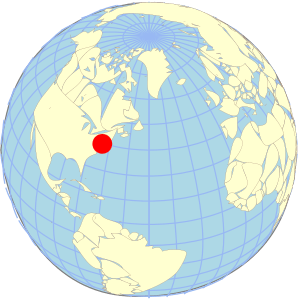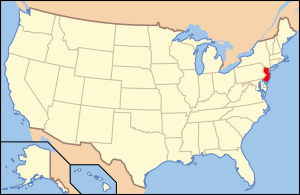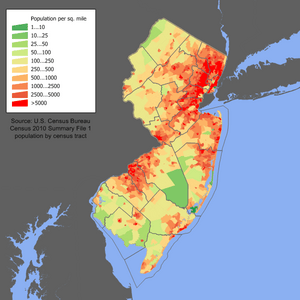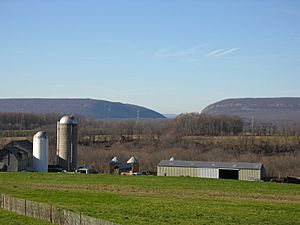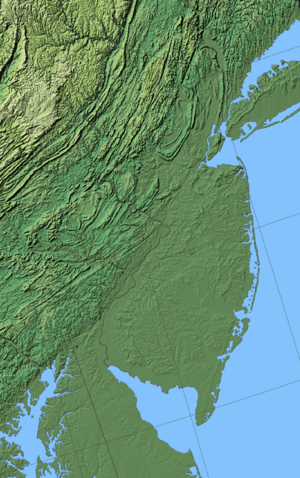Geography of New Jersey facts for kids
New Jersey is a state in the United States of America. It's located on the northeastern edge of North America. To the north, it shares a land border with New York. This border was agreed upon after a historical conflict called the New York – New Jersey Line War.
The Atlantic Ocean is to the east of New Jersey. Many famous beaches are found along the coast in places like Atlantic County, Cape May County, and Ocean County. The Hudson River separates New Jersey from parts of New York City, like The Bronx and Manhattan. Other water bodies, the Kill van Kull and Arthur Kill straits, separate New Jersey from Staten Island. Some islands, like Liberty Island and Ellis Island, are mostly in New Jersey's waters but are considered part of New York.
To the west, the Delaware River forms New Jersey's border with Pennsylvania. The Delaware Bay separates New Jersey from the state of Delaware. New Jersey's natural areas were shaped a long time ago by huge sheets of ice called glaciers.
Contents
New Jersey's Size and People
New Jersey is one of the smallest states in the United States. It ranks as the third smallest. Its total area is about 8,729 square miles (22,608 square kilometers). A good portion of this is water.
Even though it's small, New Jersey has a lot of people. It's the most densely populated state in the U.S. This means many people live close together. However, New Jersey isn't all cities and towns. Large parts of South Jersey are covered by the Pinelands National Reserve, which is over 1.1 million acres (4,450 square kilometers) of forests and wetlands. Northwestern and southern New Jersey also have very rural areas with mountains and hills. For example, Walpack Township has only a few residents in a large area.
New Jersey's Natural Features
Rivers and Waterways
New Jersey has many important rivers. Some of the major ones include the Manasquan, Maurice, Mullica, Passaic, Rahway, Raritan, Musconetcong, and Delaware.
In the past, the Delaware and Raritan rivers were used to move goods and people inland from the Atlantic Ocean. They were even connected by the Delaware and Raritan Canal. Today, these rivers are popular spots for fishing and other fun activities.
Barrier Islands
A series of barrier islands stretch along the Jersey Shore. These include islands like Long Beach Island and Absecon Island. Many of these islands are very popular places for tourists to visit, especially during the summer.
New Jersey's Geology
About 250 million years ago, the land that is now New Jersey was next to northern Africa. They were part of a huge landmass called Pangea. When North America and Africa crashed together, it created the Appalachian Mountains.
Around 200 million years ago, Pangea started to break apart. This separated North America from Africa. Much later, about 18,000 years ago, the most recent ice age brought glaciers to New Jersey. As these glaciers melted and moved back, they left behind Lake Passaic, along with many rivers, swamps, and deep valleys.
New Jersey's Natural Regions
New Jersey has many different types of land in a small area. It can be divided into five main natural regions. These regions are generally found from north to south. They are the Appalachian Valley and Ridge, Highlands, Newark Basin Piedmont, Inner Coastal Plain, and Outer Coastal Plain.
Appalachian Valley and Ridge
This region is in the northwestern part of New Jersey. It includes the Kittatinny Mountains, several smaller valleys, and the beautiful Delaware Water Gap. The highest point in the state, High Point, is located here. It stands at 1,803 feet (550 meters) tall. A large part of the famous Appalachian Trail also runs through this area.
Highlands
The Highlands region is made mostly of very old rocks. These rocks formed from heat and pressure a long, long time ago. This area stretches from the Delaware River northeast through the Skylands Region.
Many old mines can be found here. People used to dig for iron, copper, zinc, and other minerals in the 18th and 19th centuries. The northern part of this region was covered by glaciers. This created many lakes and reservoirs, which now provide drinking water for cities to the east.
Newark Basin Piedmont
The Newark Basin is a region in northern New Jersey. It's a large, bowl-shaped area that filled with sediment. This basin formed when the supercontinent Pangaea started to break apart about 220 million years ago.
This region has gentle hills and is made of reddish sediments. You can also find some interesting rock formations here, like the Palisades Sill and the Watchung basalt flows. These rock formations create dramatic changes in elevation, like The Palisades and the Watchung Mountains.
Inner Coastal Plain
The Inner Coastal Plain has lowlands and rolling hills. The ground here contains fossils from the Cretaceous period. For example, in Monmouth County, there are creeks where students can find these ancient fossils.
The soil in this region is very fertile. This makes the land great for farming. It's one reason New Jersey is called the "Garden State." Farmers have used a special type of soil called Greensand marl to help their crops grow since colonial times.
Outer Coastal Plain
The Outer Coastal Plain is made of loose sand, silt, and gravel. The soils here are sandy, more acidic, and drier than in the Inner Coastal Plain. Because the soil isn't as fertile, much of this region remains undeveloped.
The sandy Pine Barrens are in the center of this region. This area isn't good for farming, but it has many different kinds of plants and animals. Blueberries and cranberries are grown in the wet, boggy areas here.
Along the coast, sandy beaches attract many tourists. The offshore barrier islands are also popular places for vacations.
New Jersey's Natural Environment
New Jersey's natural environment has many different types of habitats. These range from the sandy shores of the Atlantic Ocean to the high Appalachian Mountains.
The sandy uplands in South Jersey are home to the Atlantic coastal pine barrens. Around the Pine Barrens, along the coast and covering the Inner Coastal Plain, are the Northeastern coastal forests. The Highlands region has Appalachian-Blue Ridge forests, which change into Allegheny Highlands forests in the far northeast.


